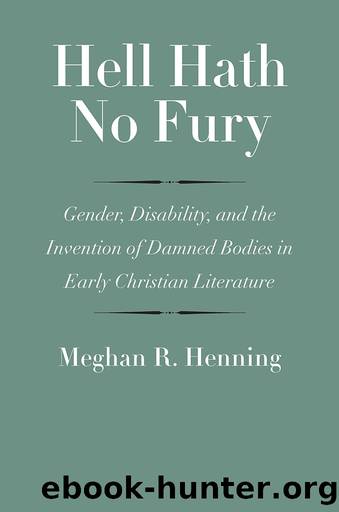Hell Hath No Fury by Meghan R. Henning;

Author:Meghan R. Henning;
Language: eng
Format: epub
Publisher: Yale University Press
Published: 2021-06-15T00:00:00+00:00
Conclusion: Making Hell on Earth
By the fifth century, the Theodosian Code brought the hellscapes of the early Christian apocalypses to earth. In this Christian compilation of Roman law, a nurse who mishandles her charge has molten lead poured down her throat, and the passive partner in a homoerotic coupling suffers burning by âavenging flames,â amputation of his hands and feet, and glossectomy (surgical removal of the tongue).1 In these punishments, as in the early Christian apocalypses, the effeminate and disabled body is on display as the sign of moral, social, and spiritual failing. Through Christian laws, hellâs womb birthed her inhabitants and their promise of bodily compromise is returned to earth.
The damned body was not simply a mirror for ancient ideas about the body or retributive logic. Rather, the body in early Christian visions of hell both reflects and constructs lived reality. The permeable barrier between this life and the afterlife allows these imagesâof tormented and deviant bodiesâto act as both mirror and blueprint; hellâs punishments for evil also construct evil. The body that threatens in hell becomes the threatening body on earth.
This give and take between the damned body and the punished body on earth belongs to early Christian discourses of bodily suffering that have until now been in the background of scholarly investigations into the roots of subjectivity in early Christian thought. For early Christians, however, the suffering object was an integral part of their cultural milieu and their moral universe. Female bodies were âassigned to suffering,â and thereby generated gendered discourses that included suffering as weakness, pain, strength, and propitious sacrifice. As we saw in chapter 1, early Christians drew on this gendered language of bodily suffering to describe the extraordinary bodies in hell. Hellâs punitive landscape in turn reified those bodily norms and associated the female, deformed, dysfunctional body with sin and punishment.
This is one of the chief ways âthe dead create and recreate social hierarchy.â2 In early Christian hell, the dead inhabit a heterotopia in which their mutilated and dysfunctional flesh is on display in order to evoke fear and disgust in the audience. This heterotopia in turn exoticized the deviant body, leveraging ancient anxieties about bodily weakness to contain sin. As we saw in chapter 3, through the torment of the damned in hell, the effeminate dysfunctional body becomes the artifact of sin. In this way, the womanly, weak bodies that are punished in hell become a way not just to put off sin, but also to distance themselves from the ways in which their own bodies already were or inevitability would become deformed or dysfunctional in some way. In ancient societies in which only a minority of the population could attain the normative body, the violent spectacle of hell reinforced a social hierarchy by demarcating the banal as the grotesque.
This marks a fundamental difference between the impaired body in antiquity and the way that disability studies theory has thought about the disabled body in modernity. Whereas the disabled body often operates at the
Download
This site does not store any files on its server. We only index and link to content provided by other sites. Please contact the content providers to delete copyright contents if any and email us, we'll remove relevant links or contents immediately.
The Five People You Meet in Heaven by Mitch Albom(3345)
Real Sex by Lauren F. Winner(2882)
Name Book, The: Over 10,000 Names--Their Meanings, Origins, and Spiritual Significance by Astoria Dorothy(2851)
The Holy Spirit by Billy Graham(2789)
The Secret Power of Speaking God's Word by Joyce Meyer(2773)
ESV Study Bible by Crossway(2688)
0041152001443424520 .pdf by Unknown(2638)
How The Mind Works by Steven Pinker(2635)
Ancient Worlds by Michael Scott(2515)
The ESV Study Bible by Crossway Bibles(2431)
The Gnostic Gospels by Pagels Elaine(2414)
The Meaning of the Library by unknow(2403)
Churchill by Paul Johnson(2380)
MOSES THE EGYPTIAN by Jan Assmann(2290)
Jesus by Paul Johnson(2240)
City of Stairs by Robert Jackson Bennett(2239)
The Complete Dead Sea Scrolls in English (7th Edition) (Penguin Classics) by Geza Vermes(2154)
Ancient Near Eastern Thought and the Old Testament by John H. Walton(2139)
The Nativity by Geza Vermes(2125)
